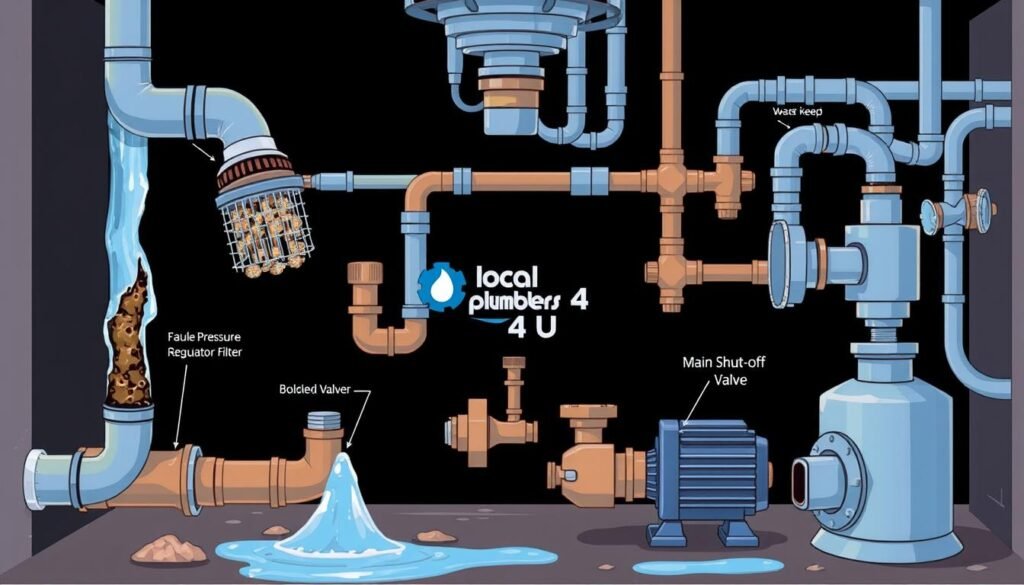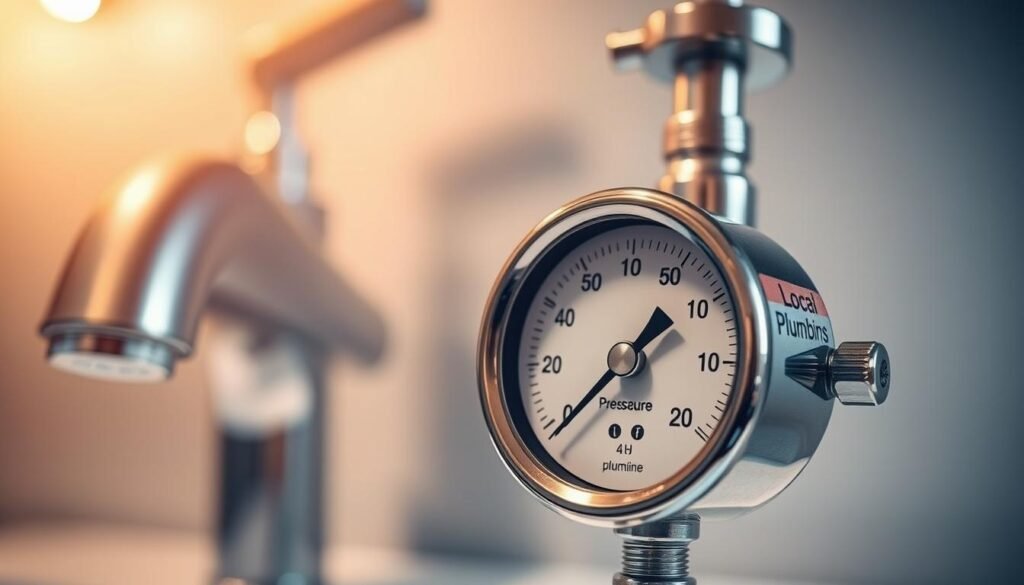Did you know that homes waste up to 10,000 gallons of water yearly due to plumbing issues? These problems often show up as lower water flow. If your shower is weak or taking too long to fill a pot, it’s time to find out why.
Weak water flow can be simple, like a closed valve, or complex, like corroded pipes. In places like the Inland Empire, Riverside County, San Bernardino, and Corona, this is common. It affects both old and new buildings.
This guide helps you find and fix your water flow problems. You’ll learn what you can do yourself and when to call a pro. For expert help, Local Plumbers 4 U in Southern California is here to help.
Whether your water pressure drops suddenly or slowly, knowing the cause saves time and money. Local Plumbers 4 U (909-378-9322) can quickly find and fix these issues for homes and businesses.
Key Takeaways
- Unresolved flow issues can waste thousands of gallons of water annually
- Problems range from simple valve adjustments to complex pipe replacements
- Early troubleshooting can prevent more extensive damage to your plumbing system
- DIY solutions work for many common causes of reduced flow
- Professional diagnosis is recommended for persistent or complex issues
- Local Plumbers 4 U offers specialized services for the Inland Empire region
Understanding Low Water Pressure Issues
When your faucets only give a trickle, it’s time to find out why. Low water pressure makes simple tasks like showering or washing dishes hard. At Local Plumbers 4 U, we know how annoying these problems can be for people in Corona and nearby.
Before we can fix low pressure, we need to know what’s causing it. Water pressure problems usually have a reason. Finding out what that reason is is key to fixing the issue.
What Causes Low Water Pressure?
Many things can make your water flow weak. Knowing what these are can help you spot problems early.

Clogged pipes and fixtures are big culprits. Over time, minerals from hard water can build up inside pipes. This makes the water flow narrower.
Corroded pipes are another big problem, mainly in older homes. Pipes made of galvanized steel or iron can corrode. This can block water flow and cause leaks.
Checking your water valves can also solve the problem. If the main shut-off valve or fixture valves aren’t fully open, it can lower water pressure. This is often missed during maintenance or after repairs.
| Cause | Frequency (%) | Typical Signs | DIY Fixable? |
|---|---|---|---|
| Clogged Aerators/Fixtures | 28% | Single fixture affected | Yes |
| Corroded/Clogged Pipes | 24% | Whole house affected | Partially |
| Partially Closed Valves | 18% | Sudden pressure drop | Yes |
| Pressure Regulator Issues | 15% | Fluctuating pressure | No |
| Municipal Supply Problems | 15% | Neighborhood affected | No |
Hidden leaks can also cause pressure drops. Even small leaks can divert water, making pressure lower. These leaks might not be seen but can cause a lot of damage.
Pressure regulators can also go wrong. If your home has one, it might need adjusting or replacing if you’re having trouble with water flow.
Lastly, problems might not be in your home. Issues with the municipal water supply can also lower pressure in your area.
Common Signs of Low Water Pressure
Knowing the signs of low water pressure can help you fix problems early. The most obvious sign is when water flow from faucets and showerheads weakens.
Water-using appliances like dishwashers and washing machines take longer to finish their cycles. This is because they use a certain amount of water, and low pressure makes it harder to fill them.
Unstable water temperature, like in showers, can also mean pressure problems. When pressure drops, keeping water temperature steady becomes hard.
Running multiple fixtures at once can also cause pressure to drop a lot. If turning on the kitchen sink makes your shower pressure drop, it’s a system-wide problem.
Importance of Addressing Low Water Pressure
Ignoring water pressure problems can lead to bigger issues. Low pressure often means there’s something wrong that could get worse and cost more to fix later.
With low pressure, using water efficiently is hard. You’ll use more water trying to do things, which means higher bills. This also makes water-using appliances wear out faster.
Having plumbing problems can also lower your home’s value. When selling your home, plumbing issues or weak water pressure can scare off buyers or lower offers.
Most importantly, low water pressure makes everyday tasks stressful. Fixing these issues can make your home more convenient and functional again.
At Local Plumbers in Corona, we know how frustrating low water pressure can be. Finding and fixing these problems quickly can save you time, money, and stress in the long run.
Diagnosing the Problem
Figuring out why your water pressure is low is the first step to fixing it. If your shower is weak or your hose can’t push water, finding the cause saves time and money. Let’s look at how to find out what’s wrong with your water pressure.
Tools You Need for Diagnosis
To solve water pressure problems, you need a few basic tools. These tools help you measure and find the issue before calling a pro.
A water pressure gauge is key. It attaches to outdoor faucets and shows the PSI. You can find these for under $15 at most hardware stores.

You’ll also need a flashlight for dark places like crawl spaces. A pipe inspection mirror helps see behind fixtures. For water tank problems, a voltage tester is useful if you think there’s an electrical issue.
Keep a notebook to write down pressure readings from different places. This helps spot patterns and is useful if you need to call Local Plumbers 4 U for help.
Steps to Check Your Water Pressure
First, see if the low pressure is everywhere or just in certain spots. Turn on faucets all over to check.
Then, use the gauge to check the pressure. Attach it to an outdoor spigot, turn on the water, and note the reading. Normal pressure is between 40 and 80 PSI, with most homes at 50 to 60 PSI.
If it’s below 40 PSI, you have a low pressure problem. If it’s over 80 PSI, it’s too high and can damage your pipes.
Make sure your main water valve is fully open. Sometimes, it gets closed by accident after repairs. The handle should be parallel to the pipe when open.
Look for leaks in your plumbing system. Even small leaks can lower the pressure. Check for water stains, dampness, or mold on walls and ceilings.
If you have a pressure regulator, check it for failure. A bad regulator can cause pressure problems.
For well systems, check the water tank. Make sure the pressure switch works and the tank isn’t full of water.
When to Call for Help
Some water pressure problems can be fixed by homeowners, but others need a pro. If you’ve tried basic steps and can’t find the problem, call a plumber.
Call Local Plumbers 4 U right away if you see sudden drops in pressure or discolored water. This could mean serious issues with your water line or supply. Also, if you hear banging or whistling in your pipes, you need help.
Problems with pressure regulators, backflow preventers, or water heaters need a pro. Trying to fix these without the right skills can cause more damage.
If your water pressure problems lead to high bills, there’s a hidden leak. Plumbers have tools to find these leaks behind walls or underground.
Regular plumbing checks can prevent many problems. Getting annual inspections from Local Plumbers 4 U can catch issues early and save you from sudden pressure drops.
Solutions to Low Water Pressure
Fixing low water pressure in your home starts with finding the right solution. It could be mineral buildup, pipe problems, or system-wide issues. We’ll look at DIY fixes and more complex solutions that might need a pro.
Simple Fixes You Can Try Yourself
Many water pressure problems can be fixed without a plumber. These DIY solutions can save you money and time. They tackle common causes of low water pressure.
First, clean your faucet aerators and showerheads. They collect mineral deposits that slow down water flow. Just unscrew, rinse, and soak in white vinegar to remove buildup. This simple faucet repair can make a big difference.
Next, check that all water valves are fully open. The main shut-off valve and fixture valves should be open. A partially closed valve can cause pressure problems easily fixed.
If you have a pressure regulator, it might need adjusting. This device controls your home’s water pressure. Look for it near your main water line and adjust the screw to increase pressure. But don’t go over 60 PSI to avoid damage.
Upgrading Your Plumbing System
When simple fixes don’t work, you might need bigger upgrades. These solutions tackle deeper problems that DIY can’t fix.
Corroded or clogged pipes can cause low water pressure. If your home has old pipes, they might be rusty. Replacing them with copper or PEX can improve water flow.
For homes with low municipal water pressure, a booster system might be needed. These systems are key when pressure is below 50 PSI. They consist of an expansion tank and a pump to maintain pressure.
Water line repair or replacement might be needed if your main line has leaks. Look for wet spots, high water bills, or pressure issues in all fixtures. These are signs of a problem.
The Role of Local Plumbers 4 U in Resolution
While DIY solutions can help, some problems need a pro. Local Plumbers 4 U specializes in fixing complex water pressure issues.
Our team can do detailed pressure testing to find the cause of your problem. We use special equipment to find leaks and measure pressure. This helps us fix your plumbing system.
For precise pressure regulator adjustments, our team ensures your system is at the right pressure. We also handle pipe replacement, from small sections to whole-house repiping.
If DIY fixes don’t work, or if you suspect a bigger issue, call Local Plumbers 4 U at 909-378-9322. Our team offers quick, professional service to fix your water pressure.
Frequently Asked Questions
Water pressure problems can be frustrating, but many solutions are within reach. Here are answers to common questions about fixing low water pressure issues in your home.
What Can I Do If My Water Pressure Is Low?
If your water pressure is low, start by checking your main shut-off valve and water meter valve. Make sure they’re fully open. A partially closed valve can cause whole-house pressure problems.
Also, inspect visible pipes for leaks or damage. These can affect water flow.
For persistent issues, clogged or corroded pipes may be restricting water even when no leaks are present. In these cases, a professional assessment is your best path to a low water pressure fix.
How Can Local Plumbers 4 U Help Me?
At Local Plumbers 4 U, we specialize in diagnosing and resolving water pressure problems quickly and effectively. Our expert technicians can:
• Evaluate your plumbing system to identify hidden issues
• Clear clogged pipes that restrict water flow
• Replace corroded pipes that narrow water passages
• Repair or replace faulty pressure regulators
• Install pressure boosters when needed
Don’t let low water pressure disrupt your daily routine. Call us at 909-378-9322 for professional assistance or visit our website to schedule a service appointment. Our team serves Corona and surrounding areas with reliable, affordable plumbing solutions.
